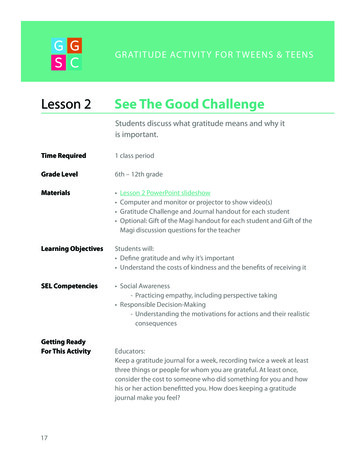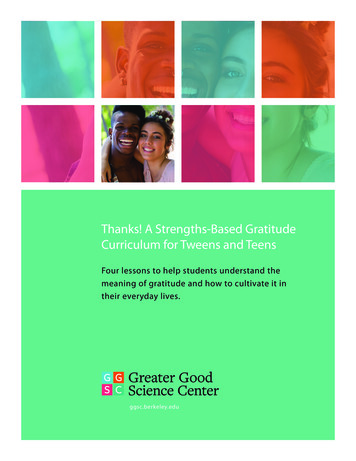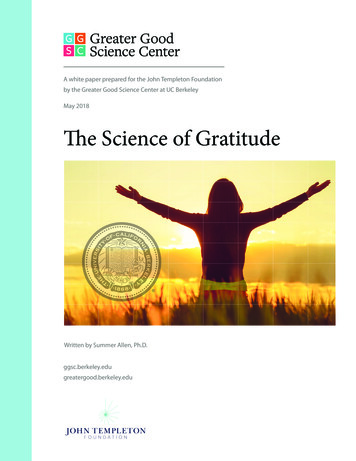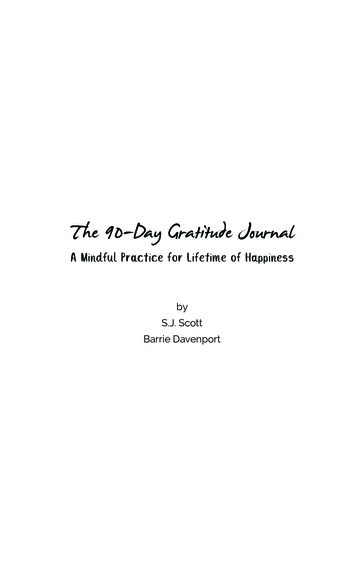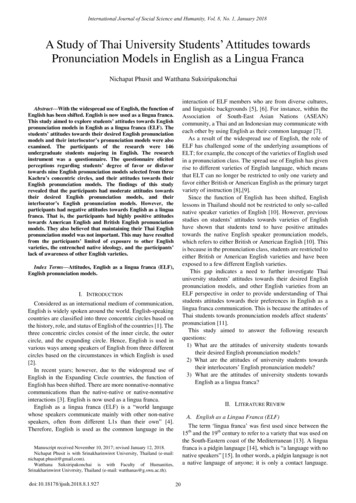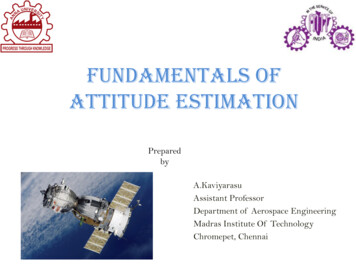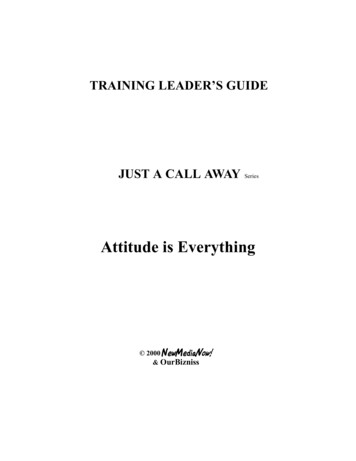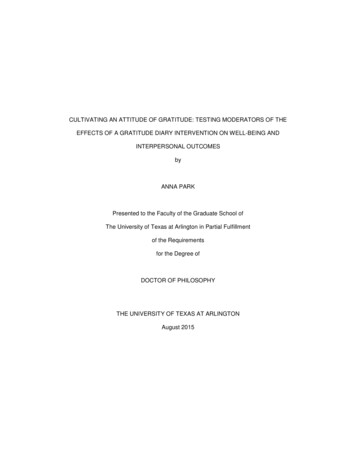
Transcription
CULTIVATING AN ATTITUDE OF GRATITUDE: TESTING MODERATORS OF THEEFFECTS OF A GRATITUDE DIARY INTERVENTION ON WELL-BEING ANDINTERPERSONAL OUTCOMESbyANNA PARKPresented to the Faculty of the Graduate School ofThe University of Texas at Arlington in Partial Fulfillmentof the Requirementsfor the Degree ofDOCTOR OF PHILOSOPHYTHE UNIVERSITY OF TEXAS AT ARLINGTONAugust 2015
Copyright by Anna Park 2015All Rights Reservedii
AcknowledgementsI would first like to thank, Dr. William Ickes, for his invaluable mentorshipthroughout my graduate school career. He has provided me with many greatopportunities and helped me become a skilled researcher. He has always demonstratedcare for his students and I have been no exception. Thanks also go to Dr. Angela LiegeyDougall and Dr. Lauri Jensen-Campbell for their encouragement and instruction. Theyhave taught me everything I know about statistics. Thank you to Dr. Jared Kenworthy forserving on all my committees and teaching me about good research design in all hiscourses. Thank you to Dr. Paul Paulus for his insightful suggestions regarding theoreticalaspects of this project. I would also like to acknowledge the help from the students in theSocial Interaction Lab who prepared the diaries for analyses. Thank you to MariaLevings, Marda Gunter, Karen Twohey, and Betty Keyes for helping me with registration,room scheduling, travel forms, and getting into my office when I have locked myself out.Thank you to my wonderful lab mates and friends, Meghan Babcock, EricRussell, Vivian Ta, Jarryd Willis, Nicole Sharp, Wen Cheng, Katy Rollings, RonenCuperman, and Robyn Petree. Thank you to Runa Korde for imparting some of herwisdom unto me. Thank you to Samara Morris-Bobzean for good conversations. Thankyou to Catherine Spann for being a source of inspiration both in research and life, ingeneral. Thank you to Becky Robinson for keeping me sane and always being helpful. Aspecial thank you to my best friend, Maria Guarneri-White, who always supports me andmakes me laugh. Thank you to my husband, Terry McCarthy, for bringing me happiness,fun, and, peace. Thank you to my sweet Mia, for just being a dog and all the wonderfulthings associated with that. Thank you to my brother, Kincade Park, for looking out for meand being a good friend. I would also like to thank my mother, Mary Park, for loving meand teaching me the importance of gratitude. In fact, it is difficult for me to think of aiii
person to whom I am more grateful in life. Finally, thank you to my father, Keith Park, agreat and kind man who inspired me to pursue a Ph.D.July 30, 2015iv
AbstractCULTIVATING AN ATTITUDE OF GRATITUDE: TESTING MODERATORS OF THEEFFECTS OF A GRATITUDE DIARY INTERVENTION ON WELL-BEING ANDINTERPERSONAL OUTCOMESAnna ParkThe University of Texas at Arlington, 2015Supervising Professor: William IckesIn the past few years, evidence has amassed suggesting that gratitudeinterventions can have a number of personal and interpersonal benefits (for a review, seeWood, Froh, & Geraghty, 2010). For instance, gratitude interventions may lead toincreases in body satisfaction (Geraghty, Wood, Hyland, 2010a), positive affect, prosocialbehavior, as well as decreased physical health problems (Emmons & McCullough, 2003).The purpose of this study was to replicate previous findings by showing that a gratitudediary intervention could improve participants’ psychological and physical well-being aswell as decrease their indirect aggression. A second aim of this study was to test whetherindividuals who scored highly on personality measures of curiosity and desire forcharacter growth would benefit more from the gratitude intervention, than individuals whoscored low on these measures.Participants first completed an online survey containing the relevant personalitymeasures as well as measures of well-being and aggression (time 1 assessment).Participants were then randomly assigned to one of three diary conditions in which theyeither wrote about things for which they were grateful (experimental condition), hassles,v
or minor details from their lives. After finishing the diary phase of the study, participantscompleted an online survey that contained all the same measures as the pre-diary survey(time 2 assessment). The gratitude intervention did not lead to improvements in theproposed outcomes and these effects were not consistently moderated by curiosity anddesire for character growth. However, preliminary results regarding the Desire forCharacter Growth Scale (DCGS), which was specifically created for this study, suggestedthat this measure is psychometrically sound and demonstrates good predictive validity.Desire for character growth measured at time 1 had a positive relationship with gratitudeat time 2, even after controlling for gratitude and social desirability at time 1. Furthermoredesire for character growth predicted happiness at time 2 controlling for happiness attime 1 and this relationship was mediated by changes in gratitude. In addition, a strongsense of self at time 1 predicted happiness at time 2, even after controlling for happinessat time 1 and other relevant predictors. Future research should further investigate the roleof sense of self in well-being as well as the psychometric properties of the DCGS and itsability to predict growth with regard to virtues beyond gratitude.vi
Table of ContentsAcknowledgements .iiiAbstract . vList of Illustrations . xiList of Tables .xiiChapter 1 Introduction. 11.1 Conceptions of Gratitude . 21.2 Overview of the Present Study . 51.3 Dependent Measures . 61.3.1 Gratitude . 61.3.2 Psychological Well-being . 71.3.3 Health Symptoms . 81.3.4 Interpersonal Cognitions and Behaviors: Envy & Aggression . 91.4 Personality Moderators . 111.4.1 Curiosity and Exploration . 111.4.2 Desire for Character Growth . 121.5 Summary of Hypotheses . 131.5.1 Dependent Measure: Gratitude . 131.5.2 Dependent Measure: Happiness . 131.5.3 Dependent Measure: Depressive Symptoms . 141.5.4 Dependent Measure: Physical Health Symptoms . 141.5.5 Dependent Measure: Indirect Aggression . 141.6 Novelty and Importance of the Present Study . 15Chapter 2 Method . 172.1 Participants . 17vii
2.2 Design . 192.3 Procedure . 202.4 Measures . 232.4.1 Control Variables . 232.4.1.1 The Shortened Social Desirability Scale (SSDS) . 232.4.1.2 The College Adjustment Rating Scale (CARS) . 242.4.2 Personality Moderators . 252.4.2.1 Desire for Character Growth Scale (DCGS) . 252.4.3 Additional Personality Measures . 262.4.3.1 The Sense of Self Scale (SOSS) . 262.4.3.2 The Mindful Attention and Awareness Scale (MAAS) . 262.4.4 Dependent Measures of Gratitude . 272.4.4.1 The Gratitude Questionnaire (GQ-6) . 272.4.4.2 The Gratitude, Resentment, and Appreciation Test (GRAT) . 272.4.4.3 The Short-Form Appreciation Scale (AS) . 282.4.5 Dependent Measure of Envy . 282.4.5.1 Dispositional Envy Scale (DES) . 282.4.6 Dependent Measures of Aggression . 292.4.6.1 Direct and Indirect Aggression Scale – Bully (DIAS-B) . 292.4.7 Dependent Measures of Psychological Well-Being . 302.4.8 Dependent Measure of Physical Health . 312.4.8.1 Daily Record Form (DRF) . 312.4.9 Measure of Mood. 312.4.9.1 Positive and Negative Affect Schedule (PANAS). . 31Chapter 3 Results . 33viii
3.1 Data Screening . 333.2 Description of Data Analytic Strategy . 353.2.1 Assessing Change in the Dependent Measures . 353.2.2 Assessing the Personality Moderators . 363.3 Psychometric Properties of the Desire for . 37Character Growth Scale . 373.4 Hypothesis Tests . 373.4.1 Hypothesis 1: Gratitude as the Dependent Measure . 373.4.1.1 Curiosity as the Personality Moderator . 383.4.1.2 Desire for Character Growth as Personality Moderator . 393.4.2 Hypothesis 2: Happiness as the Dependent Measure . 413.4.3 Hypothesis 3: Depressive Symptoms as the Dependent Measure . 433.4.4 Hypothesis 4: Physical Health Symptoms as the DependentMeasure . 453.4.5 Hypothesis 5 . 473.5 Serendipitous Findings . 503.5.1 Changes in Gratitude . 513.5.2 Changes in Happiness . 53Chapter 4 Discussion . 584.1 Possible Explanations for the Null Effects . 584.4 Conclusions . 63Appendix A Sample Items for Each Facet of the Short-Form AppreciationScale . 65Appendix B Items and Factor Loadings for the Desire for Character GrowthScale (DCGS) . 67ix
Appendix C Models with Curiosity and Desire for Character TestedSimultaneously . 69References . 76Biographical Information . 85x
List of IllustrationsFigure 1-1 Mediation Model for Hypothesis 5 . 15Figure 3-1 Desire for Character Growth Predicting Happiness Via the Mediator ofGratitude. . 57xi
List of TablesTable 2-1 Descriptive Statistics for Completers and Non-completersfor Each Condition. 18Table 2-2 Demographic Statistics for Participants . 19Table 3-1 Descriptive Statistics for Primary Study Variables. 34Table 3-2 Model Statistics for Hypothesis 1 with Gratitude as theDependent Measure . 40Table 3-3 Model Statistics for Hypothesis 2 with Happiness as theDependent Measure . 42Table 3-4 Model Statistics for Hypothesis 3 with Depressive Symptomsas the Dependent Measure . 44Table 3-5 Model Statistics for Hypothesis 4 with Physical HealthSymptoms as the Dependent Measure . 46Table 3-6 Model Statistics for Hypothesis 5 with Envy as theDependent Measure . 48Table 3-7 Model Statistics for Hypothesis 5 with Adult IndirectAggression as the Dependent Measure . 49Table 3-8 Partial Correlations Between Personality Varaiblesat Time 1 and Gratitude at Time 2 . 52Table 3-9 Regression of Gratitude at Time 2 on PersonalityVariables at Time 1 . 53Table 3-10 Partial Correlations Between Personality Variablesat Time 1 and Happiness at Time 2 . 54Table 3-11 Regression of Happiness at Time 2 on Time 1Personality Predictors . 55xii
Chapter 1IntroductionAs I began planning this project, it was the month of November and ThanksgivingDay was fast approaching. Social network sites were peppered with individuals postingabout things for which they were thankful. It seemed that gratitude, at least for some, wasa virtue that was especially salient and valued at this time of the year. On the other hand,it has always seemed ironic to me that the very holiday devoted to practicing gratitude isalso the day before Black Friday, a day marked by peak levels of consumerism.Commentators have often bemoaned the fact that Black Friday appeared to beencroaching even further upon Thanksgiving Day, as stores announced that they wouldbegin their special sales on the evening of Thanksgiving Day. One blogger for HuffingtonPost went so far as to write “Black Friday could not be contained to a mere 24 hours. It isConsumerism. It wants more. It always wants more. Nothing is sacred to it; nothing isvaluable. So, now, Black Friday has eaten Thanksgiving alive (Walsh, 2013).”Many people recognize that gratitude is an important virtue, but it can be difficultto continuously practice this virtue. The media and advertisements are forever trying toconvince us that we need more things to make us happy. Furthermore, life deals outstressors and it is difficult to be grateful and focus on the good when negative events aresalient. Yet these very facts of life underscore why gratitude may be such an importantvirtue to cultivate. Studies have shown that trait gratitude is associated with a number ofpositive outcomes, such as less materialism (McCullough, Emmons, & Tsang, 2002;Polak & McCullough, 2006). Gratitude can even help reduce distress in breast cancerpatients (Ruini & Vescovelli, 2013) and has been shown to buffer the relationshipbetween depressive symptoms and suicidal ideation (Kleiman, Adams, Kashdan, &Riskind, 2013).1
1.1 Conceptions of GratitudeFrom an empirical standpoint, gratitude has been examined in several ways.Some researchers have examined gratitude as a stable trait and found that it is related toa variety of other adaptive personality characteristics, psychological and physical wellbeing, and positive relationship outcomes (for a review see Wood, Froh, and Geraghty,2010). Other studies have used intervention techniques with the goal of activelyincreasing gratitude. One of the most common gratitude intervention exercises that hasbeen used involves asking participants to make gratitude lists. For instance, participantsmay be asked to keep a gratitude diary in which they list under each entry three things forwhich they are grateful1. The typical control groups either receive no treatment, or theykeep diaries in which they write about things, such as daily hassles, recent significant lifeevents, or mundane details of life. The results from one of the earliest gratitudeintervention studies used the diary technique and participants in the gratitude condition,relative to those in the control conditions, showed improvements in psychological andphysical well-being (Emmons & McCullough, 2003).Another study (Geraghty, Wood, & Hyland, 2010a) found that participants whokept gratitude diaries had significant decreases in body dissatisfaction compared toparticipants who had no treatment. Furthermore, the gratitude exercise was just aseffective as an established clinical technique in which participants recorded their negativethoughts and practiced replacing them with more realistic thoughts. Perhaps the mostinteresting finding from this study was that the participants in the gratitude condition wereOther interventions have involved participants being asked to write “thank you” letters tosomeone who has helped them or given them a gift, but compared to the gratitude diarytechnique, the effects of writing a “thank you” letter seem to dissipate sooner (Wood etal., 2010).12
twice as likely to complete the intervention as the participants in the other treatmentcondition.But how could one virtue be linked to so many positive outcomes? The answercould be that gratitude involves an entire “life orientation” (Wood et al., 2010). Accordingto this interpretation, gratitude is a broad dispositional approach to perceiving life—onethat is characterized by attending to and relishing positive things. There are currentlythree different self-report measures of individual differences in gratitude. The GratitudeQuestionnaire is a unidimensional measure of gratitude (McCullough et al., 2002). Othermeasures are multi-faceted, and include The Gratitude, Appreciation and ResentmentTest (Watkins, Woodward, Stone, & Kolts, 2003), and the Appreciation Scale (Adler &Fagley, 2005). These scales assess individual differences in 8 different facets ofgratitude: (1) frequency of experiencing grateful emotions, (2) feelings of appreciationtowards other people, (3) focusing on ways in which one’s life is full, rather than deficient,(4) feelings of wonderment when encountering beauty, (5) grateful behavior, (6) focusingon the positive aspects of the present moment, (7) appreciation originating from therecognition that life is fragile and short, and (8) appreciation originating from comparingone’s circumstances to individuals who are less fortunate (Wood et al., 2010).The “life orientation” approach maintains that these various conceptions ofgratitude are manifestations of a higher-order gratitude factor (Wood et al., 2010). Assuch, scores on these subscales should covary with one another and a grateful personshould tend to score highly on all of these indicators. Wood, Maltby, Stewart, and Joseph(2008) found evidence for this hierarchical structure in two large samples in which theparticipants completed all three gratitude personality measures. The results revealed thatall 8 facets loaded on a single superordinate dimension, which the authors calledgratitude.3
Readers may be wondering how trait gratitude differs from trait positivity.Positivity has typically been measured with items assessing self-esteem, optimism, andlife satisfaction (Caprara et al., 2010; Caprara et al. (2012). Gratitude is conceptuallydistinct from each of these three facets of positivity. Although similar to life satisfaction inthat it is characterized by cherishing positive aspects of life, gratitude also involves 1.) afocus on the source of that benefit (McCullough et al., 2002) and 2.) feelings of luck byrecognizing that through some benefactor one has received a gift that is not guaranteedto everyone (Roberts, 2004). Furthermore, whereas optimism concerns positiveexpectations about the future, gratitude involves celebrating positive aspects of thepresent (Wood et al., 2010). Finally, research has shown that the layperson’s conceptionof gratitude primarily involves feeling grateful to other individuals (although people alsoacknowledge that they can feel grateful for objects, events, and circumstances) (Lambert,Graham, & Fincham, 2009). This separates the construct from self-esteem whichprimarily concerns a focus on positive aspects of the self.From an empirical standpoint, gratitude appears to be separate from lifesatisfaction and optimism. A few studies of trait gratitude have demonstrated correlationswith life satisfaction ranging from .27 to .53 (Adler & Fagley, 2005; Froh, Yurkewicz, &Kashdan, 2009; Emmons & McCullough, 2003; McCullough et al., 2002; Park, Peterson,& Seligman, 2004). The correlations between gratitude and optimism have ranged from.25 to .51 (Adler & Fagley, 2005; Emmons & McCullough, 2003; McCullough et al., 2002).As such, gratitude has moderate to large correlations with each of these two constructs,but gratitude does not appear to be redundant with life satisfaction or optimism. Noknown studies have studies have examined the relationship between trait gratitude andself-esteem.4
If gratitude really is a celebration of the benefits that one has received, then itmakes sense that cultivating more grateful thoughts and emotions should produce avariety of positive outcomes. The present study of gratitude focused on four mainoutcomes: (1) general trait gratitude (2) psychological well-being, (3) physical well-being,and (4) interpersonal outcomes. The aims of the present study were to replicate previousfindings by testing whether a gratitude intervention could lead to improvements in someof the same dependent measures as previous studies, and to extend what is currentlyknown by examining potential personality moderators of these expected effects.1.2 Overview of the Present StudyIn the present study, participants were randomly assigned to one of three diaryconditions. The experimental condition required participants to write about things forwhich they were grateful. There were two control conditions—one in which theparticipants wrote about daily hassles and a second in which participants wrote aboutrecent details of their lives. Before learning of their diary condition assignment, theparticipants completed an online survey in which personality measures were obtained aswell as baseline measures of each expected outcome (time 1). The participants thencompleted three diaries per week for a total of four weeks. Their final task involvedcompleting a second online survey that contained all of the same measures that wereincluded in the first survey (time 2).This repeated measures design made it possible to test whether the participants’scores on each outcome variable changed from time 1 to time 2 and whether or not thesechanges were significantly different among the three diary conditions. By comparing thegratitude diary condition to the hassles diary condition, it was possible to test whetherfocusing on what one is grateful for is more beneficial than focusing on irritants andventing. By comparing the gratitude diary condition to the life details condition, it was5
possible to test whether keeping a gratitude diary is more beneficial than a general,neutral writing task. It was expected that participants in the gratitude condition wouldexhibit significantly better changes in their outcomes than those in the life detailscondition or those in the daily hassles condition. It was further hypothesized thatindividual differences in curiosity and desire for character growth (measured at time 1)would moderate these effects by causing participants to value and fully engage in thegratitude diary.1.3 Dependent Measures1.3.1 GratitudeA seemingly obvious prediction for the present study was that self-reportedgratitude would increase more for participants in the gratitude intervention condition, thanfor the participants in the other two conditions. This prediction is based on empiricalprecedent as previous studies have reported increases in gratitude following thecompletion of gratitude diaries. For instance, in one longitudinal study, a gratitude diaryintervention produced (Froh, Sefick, & Emmons, 2008) higher average feelings ofgratitude immediately after the participants completed each gratitude diary and at a postintervention 3-week follow-up assessment when compared to a control condition andcontrolling for baseline levels of gratitude. However, it should be noted that this studyassessed gratitude as an affective state with the measure inquiring about how intenselyparticipants had experienced grateful affect during the past day. In contrast, the presentstudy tested whether the gratitude intervention would lead to increases in a generalgrateful outlook from time 1 to time 2. The present study also examined whetherindividual differences in curiosity and desire for character growth would moderate thisproposed effect. Specifically, it was expected that individuals who scored high on these6
traits would approach the gratitude diary with more enthusiasm and therefore benefitmore than those who scored low on these traits.1.3.2 Psychological Well-beingIt is probably safe to assume that most of us want to experience the “good life.”In one study, participants from 17 different countries were asked to respond to questionsby indicating on a scale of 1 to 7 the degree to which they considered happinessimportant (Diener, 2000; Suh, Diener, Oishi, & Trandis, 1998). Tanzania had the lowestmean importance rating, but even their rating was fairly high (5.45, to be exact). Theauthors of the study concluded that the data provided evidence that the desire forhappiness is universal. Perhaps one of the most appealing characteristics of gratitude isthat it has been implicated in increasing happiness and well-being.Cross-sectional studies of trait gratitude have shown that it is negativelyassociated with depression and positively associated with positive affect (McCullough etal., 2002). In addition, gratitude intervention studies have shown similar results. Forinstance, Emmons and McCullough (2003) found that keeping a gratitude diary led tohigher levels of life satisfaction than two control conditions. Likewise, Seligman, Steen,Park, and Peterson (2005) found that increases in happiness were evident following theend of the diary task at both a 3-month and 6-month follow-up, along with significantdecreases in depression at a 1-month and 3-month follow-up. These effects may haveoccurred because the experience of gratitude is pleasant and positively valence
desire for character growth predicted happiness at time 2 controlling for happiness at time 1 and this relationship was mediated by changes in gratitude. In addition, a strong sense of self at time 1 predicted happiness at time 2, even after controlling for happiness at time 1 and other relevant predictors.
